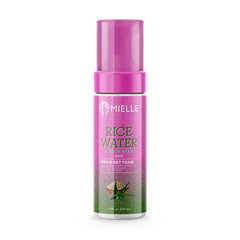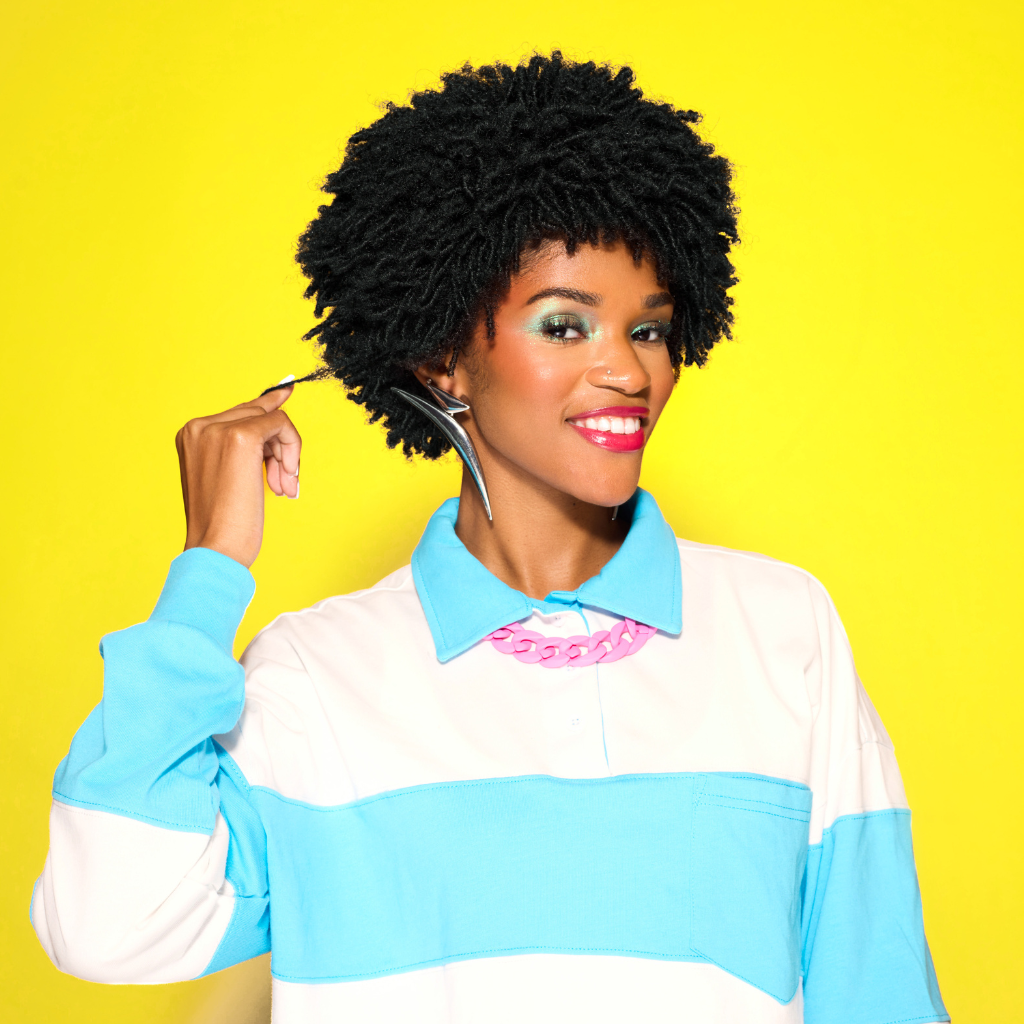By Tiffany Walker
Different Types of Natural Hair
Were you ever told your hair was “difficult” when you were a kid?
If you shied away from your hair texture, you’re not alone. Luckily, though, there’s a new renaissance of natural hair. At MIELLE, we’re happy to be at the forefront, helping women with a wide range of natural hair textures discover new ways to hydrate, define, and sport their natural texture on a daily basis with organic hair products.
The first step to up-leveling your hair care routine is understanding your natural hair texture and the best practices for keeping it happy and healthy.
Are you still asking yourself, what is my natural hair type? Or what type of curls do I have?
In this short guide, we’ll go over hair types 2, 3, and 4, as well as the best styling practices for each.
Type 2 Hair: Waves for Days
What’s Type 2 hair—and what happened to Type 1?
Stylist Andre Walker created four categories of hair with the idea that understanding your hair type helps you embrace your natural texture. Type 1 is very straight, flat hair that requires minimal upkeep, aside from washing and conditioning. This hair type differs from coily hair or curly hair, but you still may be battling frizz day-to-day.
At Type 2, we enter the world of wavy and curly hair, the kind of gorgeous hair that women of color so often rock.
Type 2 hair is defined by the following features:
- Soft, “S” shaped hair fibers – The main factor in your hair type is the shape of individual strands. After washing, pluck a few hairs from your scalp and see how they naturally curve or coil. You may even notice a few different curl shapes and widths. Type 2 ladies will see a slight S shape. (If you need to, consult a natural hair texture chart.)
- Flatter, less voluminous hair – This hair tends to lie fairly close to the head. However, some Type 2 ladies are blessed with a higher density of hair follicles, which means thick hair.
- Natural shine from scalp sebum – Our scalps naturally secrete oil that can help to hydrate and moisturize our hair. It’s much easier for this oil to travel down a straighter hair fiber than to follow the winds and weaves of a curl.
Type 2 hair is often wavy when freshly washed, but it’s also versatile—because it has plenty of natural oil, it can be straightened with heat styling tools. At the same time, it may also be able to hold a tight or loose curl.
Mariah Carey, Camilla Cabello, and Chrissy Tiegan are often seen sporting their type 2 waves. There are a few subcategories of type 2 hair:
- 2a – Some women have waves so loose they don’t even realize they’re there until they’ve spent a day at the beach.
- 2b – If you have clearly defined, S-shaped waves when your hair dries naturally, you’re type 2a.
- 2c – 2c waves are really a mixture of waves and curls. This hair texture could also be considered “borderline curly.”
Caring for Type 2 Hair
Type 2 hair can be relatively low-maintenance as compared to other Black hair types, as long as you establish a healthy hair care routine.
To make sure your hair stays hydrated and voluminous, be sure to:
- Wash and condition with organic, hydrating shampoo and conditioner about every-other-day.
- Use hydrating styling cream or other products on wet hair to give your waves definition or encourage curls.
- Prepare for heat styling with ultra-hydrating products, and use a hair mask if constant blow-drying is drying out your locks.
Type 3 Hair: Springy Curls
Gals with Type 3 hair have defined curls. From big, bouncy curls to tightly coiled locks, there is a range of Type 3 curls and ringlets.
Because each hair strand curls and coils away from the head, Type 3s tend to have more voluminous hair than their Type 2 friends. They also experience “shrinkage”—when dry, hair will look about 25% shorter than it does wet. Finally, because Type 3 hair fibers are curly, sebum will have a harder time making it to the end of each hair strand. That means Type 3 hair is prone to dryness and frizz when not properly hydrated.
Do you have Type 3 hair? If so, what kind? Pluck an individual strand of hair from your head and take a look. Notice:
- Curl shape – Lightly pull on the strand from both sides. If the curl flattens into an “S” shape, it’s a good sign you have Type 3 hair.
- Curl width – There are several subcategories of Type 3 curl, all depending on curl size/width.
Then, you can figure out which category your curl pattern falls into.
- 3a – Zendaya is often seen sporting big, loose curls that could easily wrap around a piece of jumbo sidewalk chalk. These curls are usually shiny and bouncy, although you may sometimes need a little all-natural support to get the volume you crave.
- 3b – Solange is known for her sharpie-sized curls, which also look gorgeous when softly blown out. Very voluminous, Type 3b hair is more likely to need extra moisture than extra mousse.
- 3c – Tight, pencil-sized curls like Kerry Washington’s are considered Type 3b. Ladies with this hair texture type may also sport some even more coily, z-shaped curls alongside their ringlets. 3c curls crave moisture and can use a little support for definition.
Caring for Type 3 Hair
As we’ve noted, different types of natural hair need different products and routines.
Type 3 hair is ultra-versatile. Using a blow dryer and diffuser can achieve a voluminous, cloud-like look that’s ready for a night out. Your hair also looks great with defined, air-dried curls. Finally, it’s also ready to rock a range of fly protective styles, from braids to twists and beyond.
The only trick? Making sure your hair has the hydration it needs to get strong and long without any breakage.
Treat your tresses as follows:
- Wash no more than 2-3 times per week
- Use a leave-in conditioner for added moisture
- Style with a hydrating styling cream or gel for added definition
- Use a refreshing spray when you don’t have time to wash and dry your hair
Type 4 Hair: Gravity-Defying Coils
Type 4 hair is even more closely coiled than Type 3. Sometimes called “kinky,” this hair doesn’t have as pronounced an S-shaped curve. If you pluck an individual strand from your scalp, it may have a more Z-shaped look to it.
Type 4 hair:
- Craves moisture – Because sebum has a hard time traveling down the hair shaft, you’ll need extra support. Hair oil can be a fantastic ally.
-
Has less defined curls – Each individual strand of Type 4 hair is so fine and so finely coiled, which means your hair may not clump into curls if your air-dry sans product. Don’t worry—products can help!
- Has volume, volume, volume – Due to the unique shape of your hair strands, your upright stands are well-suited for a range of bold styles, from short, bouncy pixies to natural ‘fros and beyond
- Shrinks – Your hair may look up to 50% or even 75% shorter than the actual length of the strands. To show off your length, you can try out twists, Bantu knots, and other styles that lengthen your strands.
As with hair types 2 and 3, there’s plenty of variability amongst Type 4 strands. The three categories include:
- 4a – Skai Jackson and other celebs sport 4a curls about the size of a crochet needle. Still distinctly springy and curly, your hair looks great in a range of updos and protective styles.
- 4b – Willow Smith shows that Z-shaped curls are incredibly versatile. Although voluminous, type 4a hair is usually made up of dense, thin, and fragile individual strands, which means it needs even more moisture.
- 4c – Lupita Nyong’o is iconic with her super-coily coif in endlessly versatile styles. But this still begs the question: what is 4c hair? 4c ladies have the closest coils and experience lots of shrinkage. Protective styles and hydration can be key for helping your hair grow strong and long.
At first glance, the textures between 4b hair vs 4c look very similar, but don’t be mistaken - each type requires its own hair care routine.
Caring for Type 4 Hair
Natural Type 4 hair enables you to sport a super wide array of styles. However, you’ll need to put in extra effort to keep your textured hair hydrated.
- Wash your hair no more than once per week. Always use a natural, hydrating shampoo.
- Always use a leave-in conditioner.
- Use MIELLE’s Mint Almond Oil to give your strands extra moisture.
- Apply a hair mask once per week.
- Sleep with a silk pillowcase, or use a hair wrap.
- Try out protective styles in winter, or whenever your hair needs extra TLC.
Unique Products for Unique Hair Textures
Now, you know the answer once and for all to that burning question, what kind of natural hair do I have? The next step is finding the products that bring out the best in your natural hair texture.
MIELLE’s line of all-natural, organic products is specially formulated for women like you.
MIELLE was founded to meet the need for all-natural, ultra-hydrating products uniquely designed for natural hair’s characteristics. Chemicals and additives can damage dry, frizz-prone natural hair.
With MIELLE’s ultra-hydrating products, you’ll build strength, definition, and length. Check out our products for Type 3 and Type 4 hair and customize your haircare routine today! Love styling your hair? Try our curly hair gel products to get the styled look you’ve always wanted.
Sources:
- Oprah Mag. How to Determine Your Natural Hair Type.https://www.oprahmag.com/beauty/hair/a29858581/natural-hair-types/
- Teen Vogue. Who’s Your Celebrity Curly Hair Twin?https://www.teenvogue.com/gallery/celebrity-curly-hair-twin



















